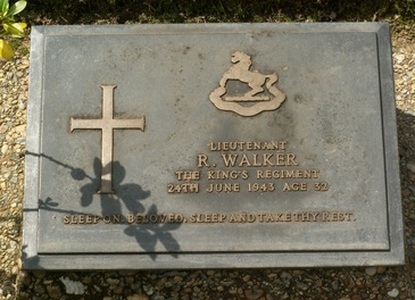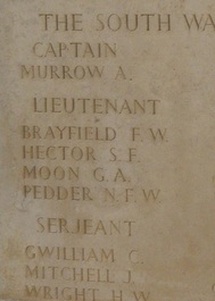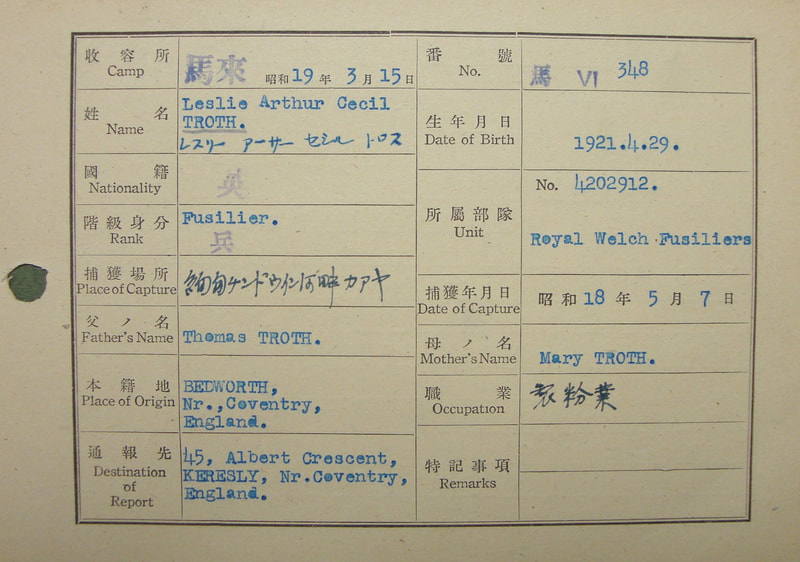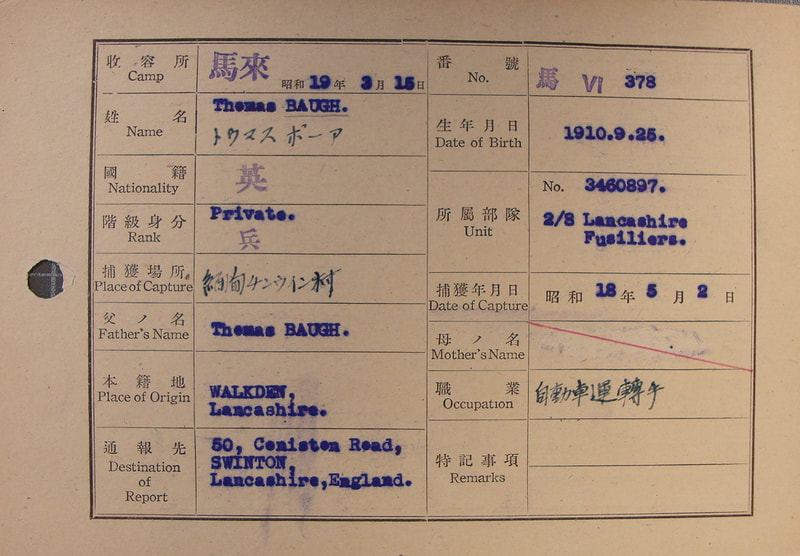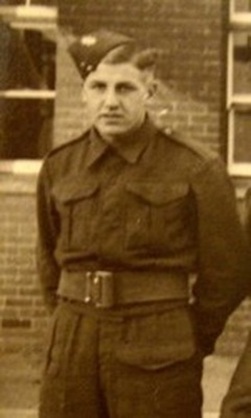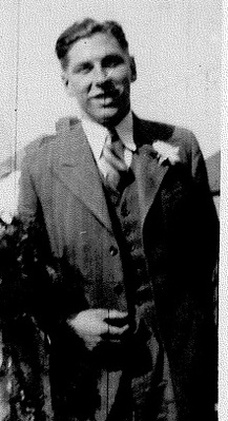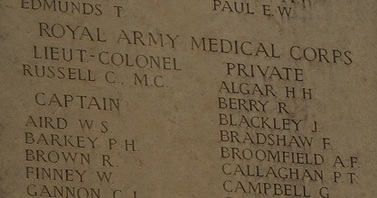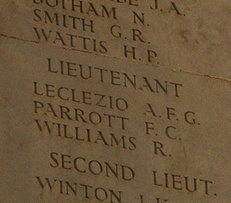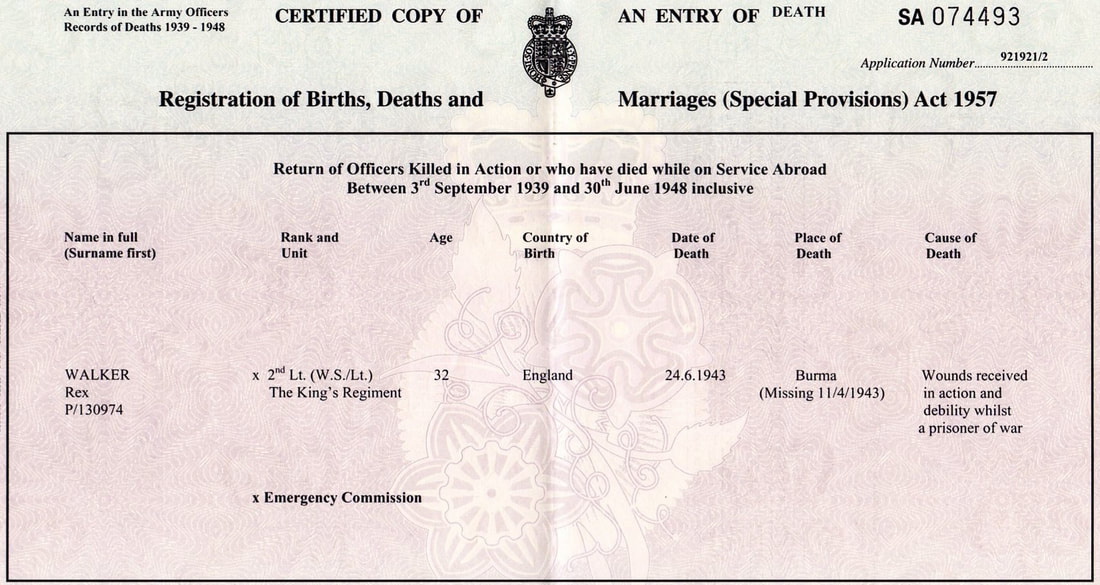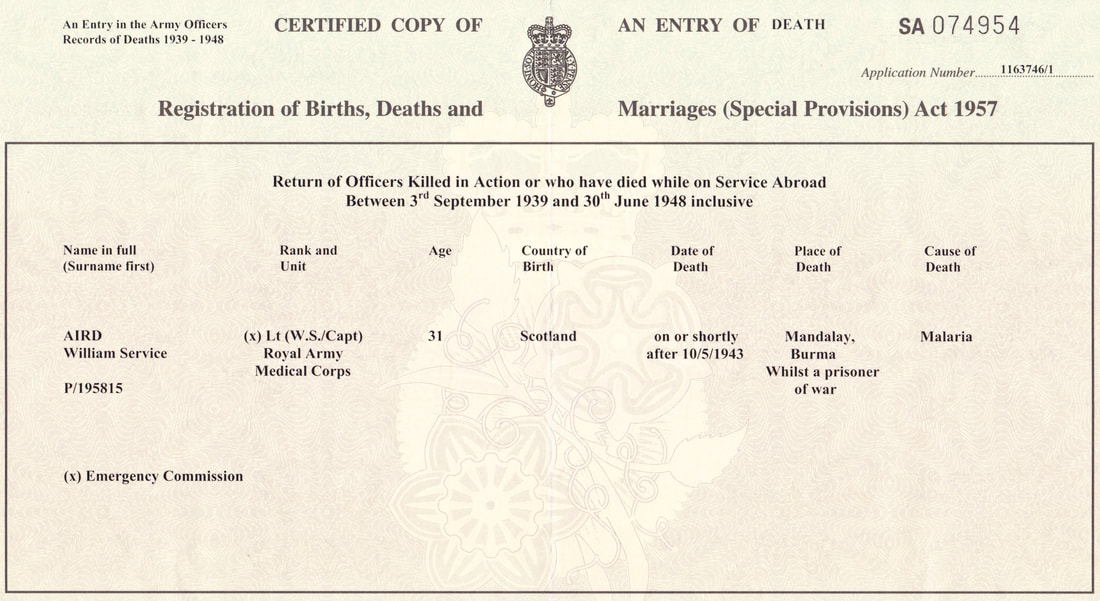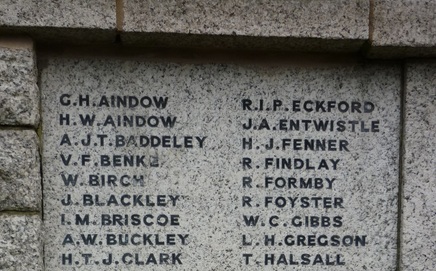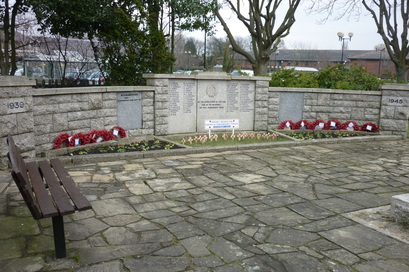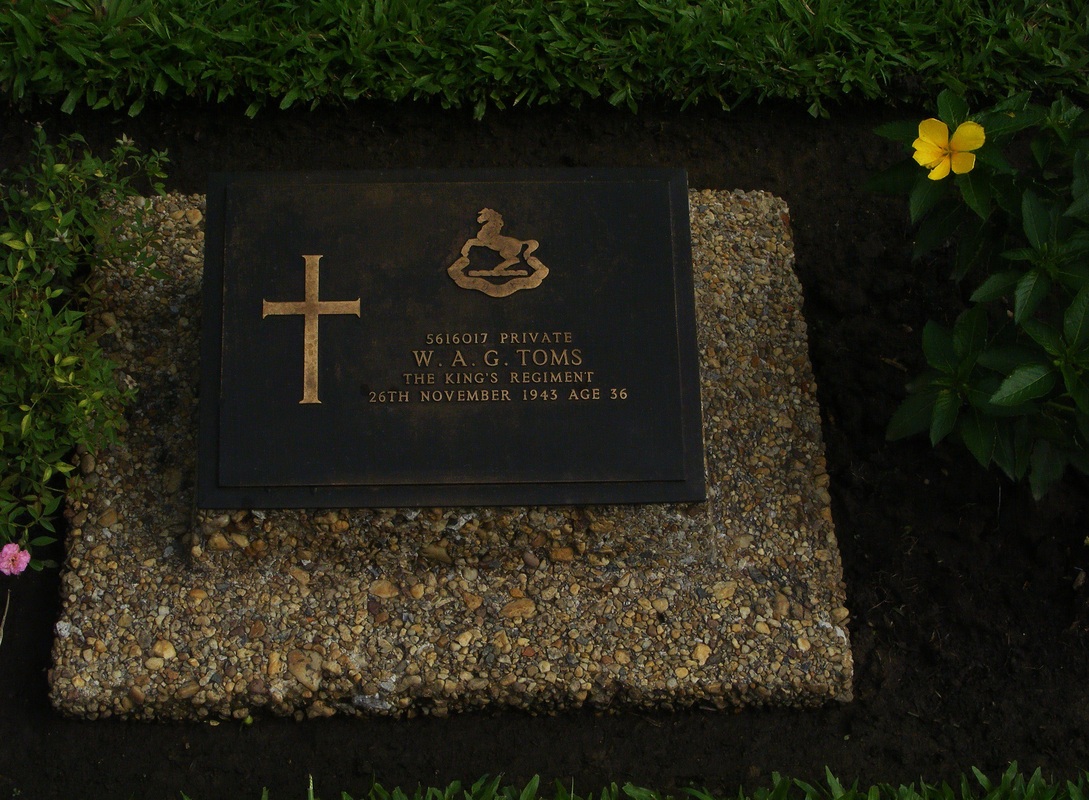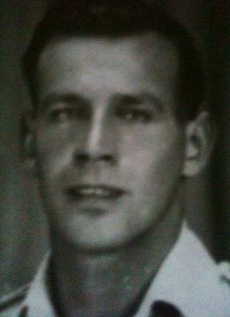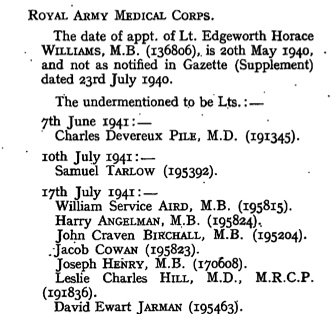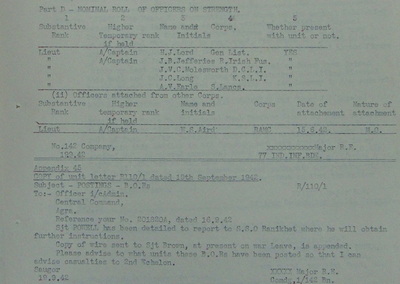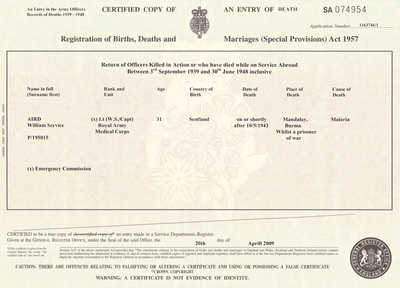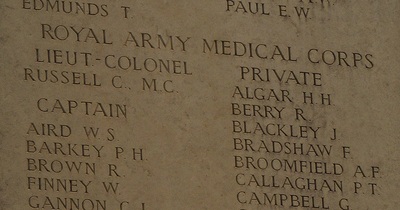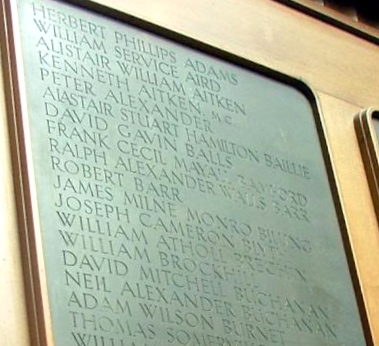Rex Walker's Dispersal Group 4, No. 7 Column
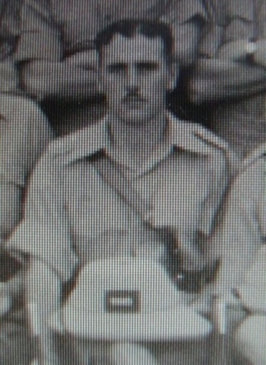 Lt. Rex Walker in Secunderabad, 1942.
Lt. Rex Walker in Secunderabad, 1942.
From the No. 7 Column War Diary pages, written by column Commander Major Kenneth Gilkes with assistance from Adjutant Captain Leslie Cottrell:
April 9th 1943:
Column was divided today, Major Gilkes (group 1) took half the men east, intending to move out by the northern China route. Lieutenant Heald (group 2) took parties across the Irrawaddy, others went with Captain Cottrell (group 3), Lieutenant R. Walker (group 4), Lieutenant Musgrave-Wood (group 5) and Campbell-Paterson (group 6).
All the groups apart from Gilkes main party were made up of 20-30 men. The four smaller dispersal groups were to rendezvous a little way further west after reaching the west bank of the Irrawaddy.
Lieutenant Walker’s party included, Captain Aird the former Medical officer of No. 5 Column, plus Lieutenant’s Hector and Anderson-Williams. A supply drop is being arranged by us for Walker’s party five days hence.
Sadly, the group never reached that supply drop rendezvous.
The men from No.7 Column, led by Major Kenneth Gilkes had decided by and large to exit Burma via the Chinese borders of Yunnan province. After the difficulties of crossing either the Irrawaddy or Shweli Rivers had been overcome, the vast majority of these men made it to Kunming, which was thankfully still in Allied hands. Gilkes had arranged a full and successful supply drop in early April and the men were restocked and refitted with new clothing and arms.
Dispersal group 4 was somewhat different and consisted of men already ill with disease or suffering from wounds gained from their earlier brushes with Japanese forces. Some of column 5 had joined up with Gilkes at the Shweli/Irrawaddy confluence and this included the column Medical officer William Aird. William the son of a physician was born in Coatbridge, north Lanarkshire and graduated from the University of Glasgow in April 1940 after ten years study. From here he joined the R.A.M.C. and ended up in India, he was a well sort after medic during Chindit training and Bernard Fergusson was pleased to have him as the column 5 doctor.
It was natural for the doctor to be placed with the sick and wounded, but a leader for dispersal group 4 was needed. Whether it was Gilkes himself or his Adjutant Leslie Cottrell that chose Lieutenant Rex Walker for this arduous task it is difficult to judge, but chosen he was.
April 9th 1943:
Column was divided today, Major Gilkes (group 1) took half the men east, intending to move out by the northern China route. Lieutenant Heald (group 2) took parties across the Irrawaddy, others went with Captain Cottrell (group 3), Lieutenant R. Walker (group 4), Lieutenant Musgrave-Wood (group 5) and Campbell-Paterson (group 6).
All the groups apart from Gilkes main party were made up of 20-30 men. The four smaller dispersal groups were to rendezvous a little way further west after reaching the west bank of the Irrawaddy.
Lieutenant Walker’s party included, Captain Aird the former Medical officer of No. 5 Column, plus Lieutenant’s Hector and Anderson-Williams. A supply drop is being arranged by us for Walker’s party five days hence.
Sadly, the group never reached that supply drop rendezvous.
The men from No.7 Column, led by Major Kenneth Gilkes had decided by and large to exit Burma via the Chinese borders of Yunnan province. After the difficulties of crossing either the Irrawaddy or Shweli Rivers had been overcome, the vast majority of these men made it to Kunming, which was thankfully still in Allied hands. Gilkes had arranged a full and successful supply drop in early April and the men were restocked and refitted with new clothing and arms.
Dispersal group 4 was somewhat different and consisted of men already ill with disease or suffering from wounds gained from their earlier brushes with Japanese forces. Some of column 5 had joined up with Gilkes at the Shweli/Irrawaddy confluence and this included the column Medical officer William Aird. William the son of a physician was born in Coatbridge, north Lanarkshire and graduated from the University of Glasgow in April 1940 after ten years study. From here he joined the R.A.M.C. and ended up in India, he was a well sort after medic during Chindit training and Bernard Fergusson was pleased to have him as the column 5 doctor.
It was natural for the doctor to be placed with the sick and wounded, but a leader for dispersal group 4 was needed. Whether it was Gilkes himself or his Adjutant Leslie Cottrell that chose Lieutenant Rex Walker for this arduous task it is difficult to judge, but chosen he was.
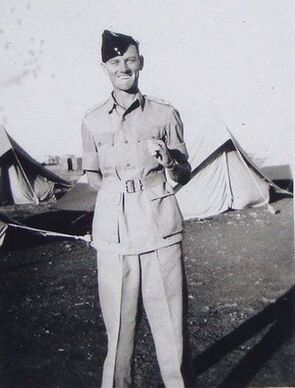 Stephen Hector at the Deolali Reinforcement Camp.
Stephen Hector at the Deolali Reinforcement Camp.
Rex had been with the 13th King’s from the outset and had been involved in his battalion’s move from their last base in England, at Blackburn, right up till they boarded the troopship Oronsay and sailed to India. Being slightly older than most of the young second lieutenants in the battalion, Rex found it difficult to settle into the group dynamic, both aboard the troopship and in the early days at Secunderabad. However, once the battalion had begun Wingate’s tough training regime, he soon found his niche and began to excel within this environment.
It seems to me that he had already shown his resilience and trustworthy nature to men like Gilkes and Cottrell early on the operation in 1943 and it was because of this that he was given the leadership of dispersal party 4.
The other two young officers that made up the leadership structure of the group were Stephen Hector and Ralph Anderson-Williams. I have made contact with the family of Stephen Hector and there is no doubt in my mind that he too was a young man of great compassion and responsibility. I would confidently say that the men who tried to lead this group, would have done absolutely everything they could to see their men back safely to India.
Below is a photograph of an appeal for information, made by the sister of Ralph Anderson-Williams in the 1995 Winter edition of the Burma Star magazine, Dekho! Sadly, after sending a letter out, some 15 years late of course, the trail had gone cold.
It seems to me that he had already shown his resilience and trustworthy nature to men like Gilkes and Cottrell early on the operation in 1943 and it was because of this that he was given the leadership of dispersal party 4.
The other two young officers that made up the leadership structure of the group were Stephen Hector and Ralph Anderson-Williams. I have made contact with the family of Stephen Hector and there is no doubt in my mind that he too was a young man of great compassion and responsibility. I would confidently say that the men who tried to lead this group, would have done absolutely everything they could to see their men back safely to India.
Below is a photograph of an appeal for information, made by the sister of Ralph Anderson-Williams in the 1995 Winter edition of the Burma Star magazine, Dekho! Sadly, after sending a letter out, some 15 years late of course, the trail had gone cold.
Here is a quote from the Missing in Action reports for 1943 and was written by Leslie Cottrell, who was Adjutant and second in command of No. 7 Column.
On April 10th we were on the Mongmit-Myitson road, Lieutenant Walker was ordered to take charge of a party of 3 officers and 25 BOR's. He was told to head westward toward the Irrawaddy and make for India by the most direct route. The group were armed and had ammunition, also they had two days hard scale rations per man. The officers had both maps and compasses. An air supply dropping was arranged for them just west of the Irrawaddy, but the party failed to make the rendezvous.
It seems very likely that the group were attacked almost straight away after splitting from the other parties from the column. The fact that two men were murdered by Burmese villagers on the 10th April, suggests to me that the vulnerable condition of the group had encouraged local villagers to attempt to capture the men in order to gain favour with the Japanese in the area.
Lieutenant Hector was reported as killed in action on 11th April and from my understanding had attempted to protect the group from enemy attacks. Whether this was from Burmese dacoits or Japanese patrols it is impossible to say for sure.
Seen below are the memorials for Rex Walker, who is remembered in Rangoon War Cemetery, having died in Rangoon Jail in late June 1943 and Stephen Hector, who is remembered on the Rangoon Memorial, having died in the Burmese jungle on 11th April that same year. (Images courtesy of asiawargraves.com
On April 10th we were on the Mongmit-Myitson road, Lieutenant Walker was ordered to take charge of a party of 3 officers and 25 BOR's. He was told to head westward toward the Irrawaddy and make for India by the most direct route. The group were armed and had ammunition, also they had two days hard scale rations per man. The officers had both maps and compasses. An air supply dropping was arranged for them just west of the Irrawaddy, but the party failed to make the rendezvous.
It seems very likely that the group were attacked almost straight away after splitting from the other parties from the column. The fact that two men were murdered by Burmese villagers on the 10th April, suggests to me that the vulnerable condition of the group had encouraged local villagers to attempt to capture the men in order to gain favour with the Japanese in the area.
Lieutenant Hector was reported as killed in action on 11th April and from my understanding had attempted to protect the group from enemy attacks. Whether this was from Burmese dacoits or Japanese patrols it is impossible to say for sure.
Seen below are the memorials for Rex Walker, who is remembered in Rangoon War Cemetery, having died in Rangoon Jail in late June 1943 and Stephen Hector, who is remembered on the Rangoon Memorial, having died in the Burmese jungle on 11th April that same year. (Images courtesy of asiawargraves.com
The original group had been reduced in number very quickly after dispersal, with up to a third of the men lost in only two days of travelling. It is difficult to know who was lost or killed where, but what we do know is that some of the party did wrestle free of that initial engagement and continue on toward their goal of the Chindwin river. The missing in action reports tell us that ‘Doc’ Aird did manage to lead a small section of men right up to the banks of that river, only to be captured by the Japanese at this final hurdle. William Aird died on the journey to Rangoon Jail on 10th May 1943; the Chindit POW’s were close to the Mandalay rail station when he passed away, suffering from both dysentery and malaria.
Of the original group only 13 made it to Rangoon Jail and of those only 4 survived to travel home to Britain after liberation. Some of the others had perished as POW’s in the Chindit concentration camp at Maymyo and were buried there just before the larger group of around 200 captured Chindits began the journey down to Rangoon.
Rex Walker suffering from a gunshot wound to his arm and having received no meaningful medical attention, died from septicaemia, as a direct result of the wound. He died in Block 6 of Rangoon Jail and had only been there a few weeks when he passed away. Ralph Anderson-Williams also perished in Block 6 of Rangoon Jail and had lasted only a few days longer than Walker.
Below are the Japanese index cards for two of the men who managed to survive their time as POW's in Burma during 1943-45. Both Arthur Troth and Thomas Baugh were liberated by the 14th Army in early May 1945, close to the Burmese town of Pegu.
Of the original group only 13 made it to Rangoon Jail and of those only 4 survived to travel home to Britain after liberation. Some of the others had perished as POW’s in the Chindit concentration camp at Maymyo and were buried there just before the larger group of around 200 captured Chindits began the journey down to Rangoon.
Rex Walker suffering from a gunshot wound to his arm and having received no meaningful medical attention, died from septicaemia, as a direct result of the wound. He died in Block 6 of Rangoon Jail and had only been there a few weeks when he passed away. Ralph Anderson-Williams also perished in Block 6 of Rangoon Jail and had lasted only a few days longer than Walker.
Below are the Japanese index cards for two of the men who managed to survive their time as POW's in Burma during 1943-45. Both Arthur Troth and Thomas Baugh were liberated by the 14th Army in early May 1945, close to the Burmese town of Pegu.
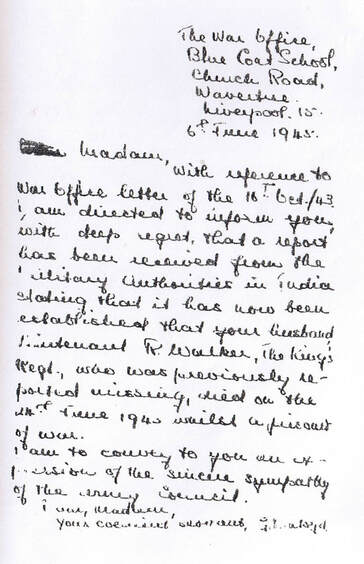
I have read about many selfless acts made by many men involved in Operation Longcloth in 1943. Some in regard to soldiers remaining behind once wounded to cover the escape of their comrades, others refusing to leave their stricken and dying pals. But I think the actions of men like Rex Walker, Stephen Hector, William Aird and Ralph Anderson-Williams go a little way beyond even these stories.
These officers could so easily have left the ill and wounded group to fend for themselves that April, after all Wingate had stated quite clearly from the beginning that any man who could not march or keep up was to be left behind. When Rex Walker took command of these already ailing soldiers, he must have known the chances of getting them back to India were incredibly slim, but he tried with every ounce of his energy and endeavour to do so. Here was a true Chindit hero.
Pictured here on the left is the War Office notification to Mrs. Walker, telling her the tragic news of her husband's death as a POW, she like so many widows had endured an agonising wait of over two years, before finally learning the truth about her loved one. (Letter courtesy of Karl Heath and the Walker family).
It simply says:
Madam, with reference to the War Office letter of the 16th Oct. 1943, I am directed to inform you with deep regret, that a report has been received from the Military authorities in India, stating that it has now been established that your husband Lieutenant R. Walker, King's Regt. who was previously reported missing, died on the 24th June 1943 whilst a prisoner of war. I am to convey to you all expression of sincere sympathy of the Army Council
Seen below is a list of the men from Dispersal Group 4 and what we now know about their circumstances and fate in 1943:
Pte. 3780025 George Adey. Was lost from the line of march on 20/04/43 and was last seen by Corporal John Kennedy.
Pte. 4206334 Henry William Aindow. Murdered by Burmese villagers on 10/04/43 as witnessed by Corporal John Kennedy. (See Henry's inscription on the Formby Memorial, Liverpool, towards the end of this story).
Pte. 3780669 William Joseph Botch. Captured while part of Walker’s group, died in Rangoon Jail 05/03/44. POW number 392.
Pte. 5627651 Frederick W. Hannaford. Survived two years in Rangoon Jail and returned home in 1945.
Pte. 5617656 Lawrence Frederick Hill. Died 01/06/43 a POW in Maymyo Camp.
Pte. 5628334 Reginald John Milkins. Murdered by Burmese villagers on 10/04/43. Has been incorrectly listed in the wrong regiment on the Rangoon Memorial, in Taukkyan War Cemetery.
Pte. 5627474 Everard Donald Rogers. Died 01/06/43 a POW in Maymyo Camp.
Pte. 5628525 William Thomas Symons. Died 01/06/43 a POW in Maymyo Camp.
Pte. 4206503 John Tonks. Left in a friendly Kachin village. Died 27/04/43 in Rangoon Jail. POW number 523.
Pte. 4197585 Ernest Walter Williams. Killed in Action on 11/04/43.
Pte. 3450897 Thomas Baugh. Liberated from Rangoon Jail/Pegu march in May 1945.
Pte. 4199398 Robert Newton. Circumstances unknown, probable POW death in Maymyo Camp.
Pte. 3861537 T. Rayson. Survived two years in Rangoon Jail and returned home in 1945. To read more about Thomas, please click on the following link: Tom Rayson
Pte. 7381858 Alan Frederick Forth. A medical orderly in column 7. Died 09/04/43 of appendicitis, although he was also suffering from severe malaria too.
Pte. 5827143 Frederick Ernest Wayman. Died of disease or wounds on 09/04/43.
Pte. 5616017 Wilfred Arthur Toms. Died a POW in Rangoon Jail on 26/11/43. POW number 531. (See photograph in update below).
Pte. 5621068 Frederick John Hartnell. Died from malaria and malnutrition in Rangoon Jail on 02/07/1943. His POW number was 508.
Pte. 5626116 Frank James Watts. Died as a POW on 01/06/43, almost certainly in the Maymyo Camp.
Seen below are photos of Fred Hartnell and Frank Watts, both of whom have their full story told on these website pages. To search for further information on any soldier mentioned above, please use the search panel found on the top right corner of this page.
These officers could so easily have left the ill and wounded group to fend for themselves that April, after all Wingate had stated quite clearly from the beginning that any man who could not march or keep up was to be left behind. When Rex Walker took command of these already ailing soldiers, he must have known the chances of getting them back to India were incredibly slim, but he tried with every ounce of his energy and endeavour to do so. Here was a true Chindit hero.
Pictured here on the left is the War Office notification to Mrs. Walker, telling her the tragic news of her husband's death as a POW, she like so many widows had endured an agonising wait of over two years, before finally learning the truth about her loved one. (Letter courtesy of Karl Heath and the Walker family).
It simply says:
Madam, with reference to the War Office letter of the 16th Oct. 1943, I am directed to inform you with deep regret, that a report has been received from the Military authorities in India, stating that it has now been established that your husband Lieutenant R. Walker, King's Regt. who was previously reported missing, died on the 24th June 1943 whilst a prisoner of war. I am to convey to you all expression of sincere sympathy of the Army Council
Seen below is a list of the men from Dispersal Group 4 and what we now know about their circumstances and fate in 1943:
Pte. 3780025 George Adey. Was lost from the line of march on 20/04/43 and was last seen by Corporal John Kennedy.
Pte. 4206334 Henry William Aindow. Murdered by Burmese villagers on 10/04/43 as witnessed by Corporal John Kennedy. (See Henry's inscription on the Formby Memorial, Liverpool, towards the end of this story).
Pte. 3780669 William Joseph Botch. Captured while part of Walker’s group, died in Rangoon Jail 05/03/44. POW number 392.
Pte. 5627651 Frederick W. Hannaford. Survived two years in Rangoon Jail and returned home in 1945.
Pte. 5617656 Lawrence Frederick Hill. Died 01/06/43 a POW in Maymyo Camp.
Pte. 5628334 Reginald John Milkins. Murdered by Burmese villagers on 10/04/43. Has been incorrectly listed in the wrong regiment on the Rangoon Memorial, in Taukkyan War Cemetery.
Pte. 5627474 Everard Donald Rogers. Died 01/06/43 a POW in Maymyo Camp.
Pte. 5628525 William Thomas Symons. Died 01/06/43 a POW in Maymyo Camp.
Pte. 4206503 John Tonks. Left in a friendly Kachin village. Died 27/04/43 in Rangoon Jail. POW number 523.
Pte. 4197585 Ernest Walter Williams. Killed in Action on 11/04/43.
Pte. 3450897 Thomas Baugh. Liberated from Rangoon Jail/Pegu march in May 1945.
Pte. 4199398 Robert Newton. Circumstances unknown, probable POW death in Maymyo Camp.
Pte. 3861537 T. Rayson. Survived two years in Rangoon Jail and returned home in 1945. To read more about Thomas, please click on the following link: Tom Rayson
Pte. 7381858 Alan Frederick Forth. A medical orderly in column 7. Died 09/04/43 of appendicitis, although he was also suffering from severe malaria too.
Pte. 5827143 Frederick Ernest Wayman. Died of disease or wounds on 09/04/43.
Pte. 5616017 Wilfred Arthur Toms. Died a POW in Rangoon Jail on 26/11/43. POW number 531. (See photograph in update below).
Pte. 5621068 Frederick John Hartnell. Died from malaria and malnutrition in Rangoon Jail on 02/07/1943. His POW number was 508.
Pte. 5626116 Frank James Watts. Died as a POW on 01/06/43, almost certainly in the Maymyo Camp.
Seen below are photos of Fred Hartnell and Frank Watts, both of whom have their full story told on these website pages. To search for further information on any soldier mentioned above, please use the search panel found on the top right corner of this page.
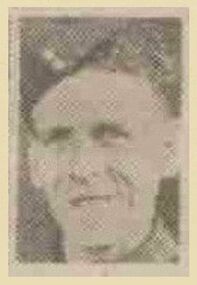 L/Cpl. Joseph Kay.
L/Cpl. Joseph Kay.
The dispersal group personnel continued:
Lance Corporal 3781435 Joseph Kay. Died in Rangoon Jail on 02/09/43. His POW number was 494. Joseph's death whilst in Japanese hands was confirmed in the Manchester Evening News, dated Friday 8th June 1945.
Pte. 4202912 L.A.C. Arthur Troth. Missing in Action on 10/04/43 was eventually liberated form Rangoon Jail/Pegu march in early May 1945. Pte. Troth was batman to Lieutenant Stephen Hector during his time as a Chindit. To read more about this soldier's experiences on Operation Longcloth, please click on the following link: Pte. Leslie Arthur Cecil Troth
Lance Corporal 3780671 Ernest Herbert Burgess. Died in Rangoon Jail on 18/03/1944. His POW number was 516.
Corporal 3186236 John Kennedy. Liberated from Rangoon Jail/Pegu march in early May 1945. Gave numerous witness statements on debrief to the British Indian Army office, including information about several of Walker’s dispersal party.
CQMS 3780152 Thomas Samuel Partington. Died in Rangoon Jail on 15/01/1945 suffering from beri beri and dysentery. His POW number was 108. " For some time he had the thankless task of being the senior NCO in the turbulent and ramshackle Block 6 of Rangoon Jail. He did his best, and it was a very good best. Poor chap died quite early on of dysentery." A quote about Thomas Partington from the memoir of Lieutenant 'Willie' Wilding.
Sergeant 3780708 Alfred Christopher O’ Gorman. Died on 10/04/43. Drowned in Irrawaddy River even though he was reported to be a very strong swimmer (source 7th column War diary).
Captain 195815 William Service Aird. No. 5 Column Medical Officer, died close to Mandalay rail station on 10/05/43 suffering from dysentery and malaria.
Lieutenant 153850 Ralph Anderson Williams. Date of death on the CWGC is 24/06/1943, but he features on the lists for Block 6 as having died in Rangoon Jail on 30/06/43. POW number 486.
Lieutenant 172208 Stephen Frederick Hector. Killed in Action on 11/04/43. Lost on the Myitson-Mongmit Road. To read more about Stephen Hector, please click on following link: Family 3
Lieutenant 130974 Rex Walker. Given command of dispersal group 4 by Major Gilkes. Died in Rangoon Jail on 24/06/43 suffering from septicaemia caused by a gun shot wound to his arm. His POW number was 481.
Below are the inscriptions for William Aird and Ralph Anderson-Williams as seen on the Rangoon Memorial, located at Taukkyan War Cemetery, Burma. Images courtesy of: asiawargraves.com
Lance Corporal 3781435 Joseph Kay. Died in Rangoon Jail on 02/09/43. His POW number was 494. Joseph's death whilst in Japanese hands was confirmed in the Manchester Evening News, dated Friday 8th June 1945.
Pte. 4202912 L.A.C. Arthur Troth. Missing in Action on 10/04/43 was eventually liberated form Rangoon Jail/Pegu march in early May 1945. Pte. Troth was batman to Lieutenant Stephen Hector during his time as a Chindit. To read more about this soldier's experiences on Operation Longcloth, please click on the following link: Pte. Leslie Arthur Cecil Troth
Lance Corporal 3780671 Ernest Herbert Burgess. Died in Rangoon Jail on 18/03/1944. His POW number was 516.
Corporal 3186236 John Kennedy. Liberated from Rangoon Jail/Pegu march in early May 1945. Gave numerous witness statements on debrief to the British Indian Army office, including information about several of Walker’s dispersal party.
CQMS 3780152 Thomas Samuel Partington. Died in Rangoon Jail on 15/01/1945 suffering from beri beri and dysentery. His POW number was 108. " For some time he had the thankless task of being the senior NCO in the turbulent and ramshackle Block 6 of Rangoon Jail. He did his best, and it was a very good best. Poor chap died quite early on of dysentery." A quote about Thomas Partington from the memoir of Lieutenant 'Willie' Wilding.
Sergeant 3780708 Alfred Christopher O’ Gorman. Died on 10/04/43. Drowned in Irrawaddy River even though he was reported to be a very strong swimmer (source 7th column War diary).
Captain 195815 William Service Aird. No. 5 Column Medical Officer, died close to Mandalay rail station on 10/05/43 suffering from dysentery and malaria.
Lieutenant 153850 Ralph Anderson Williams. Date of death on the CWGC is 24/06/1943, but he features on the lists for Block 6 as having died in Rangoon Jail on 30/06/43. POW number 486.
Lieutenant 172208 Stephen Frederick Hector. Killed in Action on 11/04/43. Lost on the Myitson-Mongmit Road. To read more about Stephen Hector, please click on following link: Family 3
Lieutenant 130974 Rex Walker. Given command of dispersal group 4 by Major Gilkes. Died in Rangoon Jail on 24/06/43 suffering from septicaemia caused by a gun shot wound to his arm. His POW number was 481.
Below are the inscriptions for William Aird and Ralph Anderson-Williams as seen on the Rangoon Memorial, located at Taukkyan War Cemetery, Burma. Images courtesy of: asiawargraves.com
Finally, here are copies of the Army Overseas Death Certificates for Rex Walker and William Aird, showing their personal details, POW status and cause of death. William Service Aird MB/CHB had graduated from the University of Glasgow on 20th April 1940, following in the medical footsteps of his father Robert who was also a physician. Please click on the link below to view details of his University days:
http://www.universitystory.gla.ac.uk/biography/?id=WH0694&type=P
Shown below the two certificates are photographs of the Formby War Memorial in Liverpool and the inscription for Pte. Henry William Aindow. Please click on any of these images to bring them forward on the page.
http://www.universitystory.gla.ac.uk/biography/?id=WH0694&type=P
Shown below the two certificates are photographs of the Formby War Memorial in Liverpool and the inscription for Pte. Henry William Aindow. Please click on any of these images to bring them forward on the page.
Update 02/01/2013. Wilfred Toms.
In early November 2012, I was contacted by Natalie Thomas and Christine Jefferis Knight. They had seen my posts on the WW2Talk forum and my article about the Devonshire Regiment Chindits on the Devonshire Heritage website. They were searching for information about Pte. Wilfred Arthur George Toms, a relative of theirs who had died in Burma in WW2. Here is what Christine had to say about her search for her second cousin Wilfred:
I hope you don't mind me writing to you, I have recently found out that a relative of mine died in WW2 and is buried in Rangoon Cemetery, on further searching I came across the Devon Heritage site and your article on the Devon Jungle Kings. I was totally amazed to read that my relative, who I believe is my second cousin was actually mentioned. His name was Wilfred Arthur George Toms, his service number was 5616017, he served with the 13th Btn. Kings Regt. (Liverpool) and died on 26/11/1943.
Wilfred was the son of my great aunt Amelia Toms, his father was Frederick Toms and they were originally from Millbrook in Cornwall until the family moved to the Surrey area just before the war .
I am eager to learn more about Wilfred and as you seem to have studied these men I wondered if you had any further info on him please, we are not sure how he died and would like to have whatever information you may have. Sadly Wilfred had another brother (Reginald) who was also killed in WW2 but not in the same place, as we are trying to piece together the family history I would so appreciate anything you may have to help us understand how Wilfred died.
Thank you so much for your time and I look forward to hearing from you. Christine.
And here is what Christine's daughter Natalie had to say on the WW2Talk forum back on 4th November 2012:
Re: Wilfred Alfred George Toms...POW Rangoon Jail
Hi All, I am very new to this so please bare with me.
I have been for the last few years researching my family tree...this has taken me in several different directions...but only today I learned that my great grandmother's sister had a son, Wilfred Alfred George Toms who was a POW at Rangoon Jail. The information I have found so far is that he was reported M.I.A on the 10th of April 1943, but was to later die on the 26th of November 1943 in Block 6. I have searched several archives but have since come up with a blank...would anybody be able to shed some light on how he died.
Many thanks.
I was able to hand over some details about Wilfred's time on Operation Longcloth in 1943, but sadly, due to the lack of a Japanese POW index card, not his ultimate cause of death. Seen below is his grave plaque at Rangoon War Cemetery and a photograph taken of Wilfred on his last leave before going overseas. I would like to thank Christine and Natalie for their help in adding this new information and photograph in regard to Pte. Toms.
William Service Aird
A quotation from Bernard Fergusson's book, Beyond the Chindwin, as the men of 5 Column approached the town of Tigyaing on the outward journey to the Irrawaddy in early March 1943:
Bill Aird, whilst sitting on his pack eating a banana, enquired of me (Fergusson): Could I go and have a look at this Irrawaddy, sir? It would be a pity if we didn't get across today, and I couldn't even say I'd seen it, after coming all this way!
For some time now I have wanted to add some more information to these pages about Captain William Service Aird of the RAMC. William was the son of Robert and Agnes Aird from Glasgow. As mentioned before, William's father was also a doctor and presumably William wanted to follow in his footsteps and work in the medical profession after graduating from the University of Glasgow in April 1940.
195815 William Service Aird was promoted to Full Lieutenant in the Royal Army Medical Corps on the 7th June 1941, shortly after which he was sent overseas to serve in India. Eventually he came to work at the British Military Hospital in Calcutta and it was from here that he was transferred to the 77th Indian Infantry Brigade on the 2nd July 1942, now with the rank of Acting Captain.
Initially, William worked with the 142 Commando section of the Brigade at the Chindit training camp in Saugor. He was kept extremely busy here looking after the various medical needs of the unit. He was to become not just a well respected Medical Officer within 142 Commando, but also a very popular and much-loved comrade and confidant.
During the period at Saugor, William treated many of the Brigade for various illnesses, diseases such as malaria and of course wounds suffered as a consequence of the many training courses that sometimes used live ammunition and explosives. He was perhaps the most travelled Medical Officer in the Brigade and served at one time or another in almost all the individual Chindit Columns. By the latter quarter of 1942 he had settled into his final position as the Medical Officer for No. 5 Column and it was with this unit that he entered Burma in February 1943.
William joined Major Fergusson and 5 Column around the Christmas period of 1942, taking his place amongst the many other Scots within the leadership of this Chindit unit. In his book, Beyond the Chindwin, Bernard Fergusson remembered that time:
Bill Aird, my doctor, at last came to rest in No. 5 Column at this time, having wandered from column to column during previous month. Until now, we had only had three doctors for the whole Brigade, who were not allotted to specific columns; but Bill and I had long plotted that when the time came he should join me. He belonged to Glasgow and had a great sense of humour; the men were very fond of him, he and I had much in common, and altogether it was a most successful partnership.
Later on in the book, Fergusson recalls the time when 'Doc' Aird approached him about the declining health of the column, after they had yet again missed out on a scheduled air supply drop inside Burma.
But the supply problem was now serious. Not only could I get no drop: I could not forage; for if the Japs had patrols in the neighbourhood, I could not enter villages without it becoming known and attracting further attention to the very area which Brigade should reach in three or four days. I gave an order to tighten belts.
Bill Aird and John Fraser now both came to me with long faces. They had been putting their heads together, and decided that it was their duty to tell me their opinion of the state of the troops. In Bill's professional opinion, they were, physically speaking, only sixty per cent effective. The long marching on short commons had, in his opinion, so undermined them that they must have at least a fortnight's rest on decent rations before another effort was asked of them.
This communication came as a complete shock to me. The very fact of being the commander lends a certain exhilaration to one's acts, and helps one to ignore physical decline. I knew we were all hungry and losing weight, but I confess I had not thought of it in quite such a gloomy light as this.
Later still, Fergusson recounts the moment he lost his doctor, after the column's battle with the Japanese at the village of Hintha:
When Peter Buchanan and I reached my bivouac, I was delighted to find Denny Sharp, Jim Harman and most of his commandos, Gerry Roberts and his platoon, Bill Edge, Pepper, Foster and White, all arrived in.
They had had a longer march than we, having failed to get down the chaung, and having been compelled to go back up it the way we had come in, the previous evening. Once on the hill, they got away across country; but while climbing up it, two of the most precious mules of the whole string had tumbled over the cliff into the chaung below: one carried the wireless, and the other the ciphers.
Lance-Corporal Lee had gone back down to recover the ciphers, and had not been seen since. They had heard, as they came away, the sound of explosions from the dummy bivouac, where some Nips presumably paid the price of their inquisitiveness. Otherwise they had not been interrupted. There had, however, been one more serious loss: while going through some elephant grass, their column had split in two, and the rear half had not caught them up again. Among those whom they had thus lost were Pam Heald and all the Burma Rifles, bar one Rifleman, Maung Kyan; Bill Aird and some wounded ; Serjeant-Major Cairns and the Colour-Serjeant; Willy Williamson and most of the Support Platoon; Bill Smyly and most of the Gurkhas.
Nobody had seen David Whitehead, and I was worried about him and Lance-Corporal Lee; about the others, I was pretty sure that they could look after themselves, and would turn up all right.
During the engagement at Hintha, Fergusson, concerned at the way the action was going sent Denny Sharp away from the village with the majority of the column. This group was ambushed not long afterwards and around one hundred men were separated from the main body of 5 Column once and for all. William Service Aird was amongst this group. Fortuitously, the separated party were to bump into Major Gilkes and 7 Column close to the banks of the Shweli River and they took them under their wing. This is how William came to be with Lieutenant Rex Walker and the sick and wounded of Dispersal Group 4.
Another officer who formed part of the separated section from 5 Column, was Animal Transport Officer, Lieutenant William Smyly of the Gurkha Rifles. Bill Smyly once told me that he remembered 'Doc' Aird with great fondness and especially how he struggled to persuade the Gurkhas in the column to accept his medical advice once inside Burma. The Gurkhas looked upon some of the medicines issued, especially the anti-malaria drug, mepacrine, with great suspicion. Once the doctor had proved his worth by keeping one Rifleman alive after he had been wounded early in the expedition, the Gurkhas seemed to lose their superstitious outlook and held William Aird in great esteem from that moment on.
As we know, Bill Aird did not make it out of Burma in 1943. He had courageously remained with the already sick and wounded at dispersal, joining up with Rex Walker, Stephen Hector and Ralph Anderson Williams in their attempt to lead some twenty-five men to safety across the Irrawaddy River.
William Aird died on or shortly after the 10th May 1943, a prisoner in Japanese hands. It was reported that he was suffering from both malaria and dysentery at this time. His body was never recovered after the war was over and for this reason he is remembered upon the Rangoon Memorial at Taukkyan War Cemetery. William is also remembered upon the Glasgow Academy Memorial for WW2, situated on the first floor of the main building in Colebrooke Street.
To view William's CWGC details, please click on the following link:
http://www.cwgc.org/find-war-dead/casualty/2130647/AIRD,%20WILLIAM%20SERVICE
The previous service of William Aird at the Chindit training camp in Saugor is also mentioned in another story from these pages, linked here:
Ted Stuart, Almost but not Quite
Philip Stibbe had this to say when learning of William's death in Burma. From his book, Return via Rangoon:
I had been a prisoner for a few weeks when I learned from other 5 Column men that Doc Aird had died. Nobody was more generally regretted; he had been extremely popular with all ranks and everyone in the column was delighted when, in spite of ill health, he insisted on coming into Burma with us. I heard from the men who were with him when he died that, with typical devotion, he continued to look after the other sick prisoners as long as he was able to move himself.
Seen below are some images in relation to the story of Captain William Service Aird, please click on any image to bring it forward on the page.
I have decided to give Bernard Fergusson the last word, in the form of his fitting tribute to the medical officers present with the Chindits in both 1943 and 1944 and in particular William Aird. From his book Wild Green Earth written in 1946:
In all this talk of health and nutrition, in which I may have seemed to claim undue knowledge and wisdom, I have not yet made clear our realisation of the debt which we owe to our doctors. No commander was ever more lucky than I was in this respect.
The first year I had Bill Aird of Glasgow, the first Chindit doctor in length of service with the Force, and not the least able nor the least loved. He stayed with a party of wounded that grim morning when we were broken up at Hintha.
Not all of them got across the Irrawaddy; not all survived the crossing; but with some, sick as he was with fever and dysentery, Bill reached the very Chindwin before he and they were caught by the Japs on the threshold of safety. He did not live long; he was dead before they got him to Mandalay; but he will be remembered all the lifetime of the old hands in No. 5 Column.
Copyright © Steve Fogden 2011/14.

